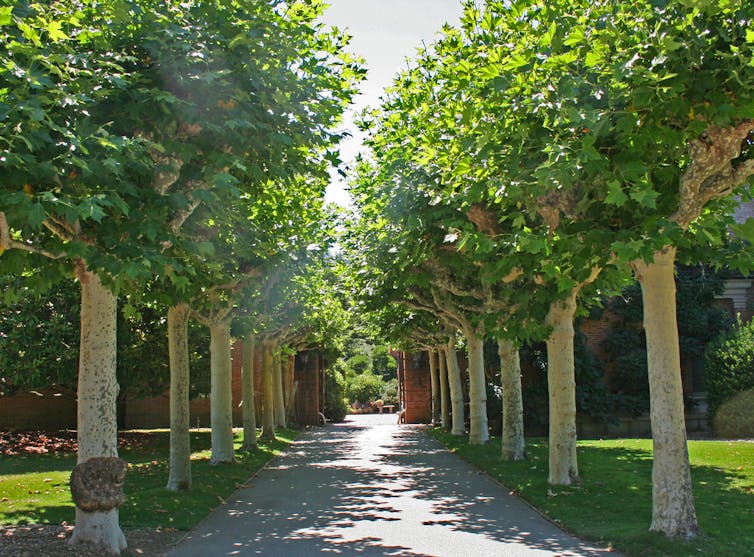Spring brings with it hay fever and red eyes for many inner-city residents and in absence of fields of flowering grasses, people turn their attention to other possible causes. The most suspicious candidate, with its new leaves and flower buds, is the London plane tree.
Plane trees are commonly planted along the pavements and parklands in the inner-city areas of several Australian and European cities. They are popular with town planners as they are deciduous, pollution-tolerant, quick-growing and well-shaped. They provide welcome shade in summer, reduce the urban heat-island effect, improve local ambience, and even add a European touch to Australian cities.
But plane trees are also blamed by residents for provoking nasal, throat and eye symptoms. In Sydney, this led to the “No more plane-trees” action group whose aim was to raise awareness and lobby councils to substitute new planting with less irritating species. The issue became politicised between residents and councils, and was fuelled by the fact that accurate and locally-relevant information on the health risks posed by plane trees is scarce.

Indeed, it’s not known to what extent people have a true allergy to plane tree pollen and whether the airborne fine spiky “hairs” (called trichomes) from the back of the leaves contribute to the symptoms. So our respiratory research group decided to examine airborne pollen exposure in inner Sydney and its relationship to symptoms to find out.
The experiment
We set up public booths at markets in the inner-city suburbs of Kings Cross and Paddington and recruited 64 local residents who attributed their spring symptoms to plane trees.
All the subjects were tested for allergies to a range of pollens, including plane tree, as well as fungi and indoor allergens, such as dust mites and cats. And they all agreed to keep a written diary of symptoms.
During the period July 2006 to April 2007, we located air-sampling devices on the roofs of three buildings to collect a continuous record of airborne pollens in the area of the residences. These samples were examined for pollens, fungi and other airborne plant fibres, which were identified and counted.
Residents were also supplied with small sampling devices to be worn in the nose to collect what they inhaled, and instructed to wear these in the street for half an hour on occasions when they thought they were getting symptom-causing exposure.
What we found
Of the 64 people tested, we found that 86% of the subjects were allergic to something (mites, cats or pollens, for instance). Two-thirds were allergic to one of the pollens tested (including 56% to ryegrass and 41% to Bermuda grass), but only about a quarter were allergic to plane trees. All those allergic to plane trees were also allergic to grasses. And seven of the 64 (12%) were not allergic to anything.

The relatively low rate of plane tree allergy was surprising, particularly when we found that plane tree pollen accounted for about three-quarters of the total pollen over this time. The season for plane tree pollen was intense but short, starting in September with decreasing amounts through to November.
Pollens from plants other than plane trees also started in September, but continued at a lower rate right through to April the following year. The trichome fibres from plane trees started in October and persisted through to December.
The pattern of reported symptoms occurred over a longer timeframe than the plane tree pollen season and was weakly related to the total period when plane tree and other pollens, and plane tree trichomes were all present in the air. The individual effects of each of these could not be distinguished, despite additional analyses in which subjects were divided into groups based on different pollen allergies.
Only eight people used the nasal samplers and when these were analysed, the most frequent particles were trichomes, followed by plane tree and grass pollens. But such a sample is much too small to draw any conclusions from.

There’s also anecdotal evidence from arborists and from our experience in conducting the study that supports the irritant effect of the trichomes for throat and eye symptoms. Such irritation might also explain symptoms in the few non-allergic and the non-plane tree allergic subjects in the study. But better establishing this role would require more research under controlled conditions.
Other factors
We weren’t able to clearly establish a primary role for plane tree pollen allergies in generating eye, nasal and throat symptoms in inner city-residents. The symptoms occurred over longer timeframes than plane tree pollen exposure, and non-plane tree allergies were more than twice as common. So we suspect that other pollens also contribute to allergic symptoms, and that the tiny, spiky protective fibres derived from the leaves of plane trees probably play a non-allergic, irritant role in a range of symptoms too.
There were limitations in our study such as the variability in exposure – some residents have large plane trees literally on their doorstep, while we measured our exposure on the roofs of buildings hundreds of metres away.
So do plane trees cause hay fever symptoms? The answer is a guarded yes – particularly in September, among people with allergies. It’s also likely but unproven that plane tree leaf trichomes cause a range of irritant effects in a wider population and for longer. And there are clearly other allergic causes of symptoms in the inner city as well. Their sources include other tree species, and grasses in local parks.
Even though we weren’t able to find a definitive link between hay fever and plane trees, this new awareness may not be in vain. Our understanding is that local councils are moving towards planting a range of other, less allergenic exotic and indigenous trees in streetscapes, so perhaps change is in the air after all.

